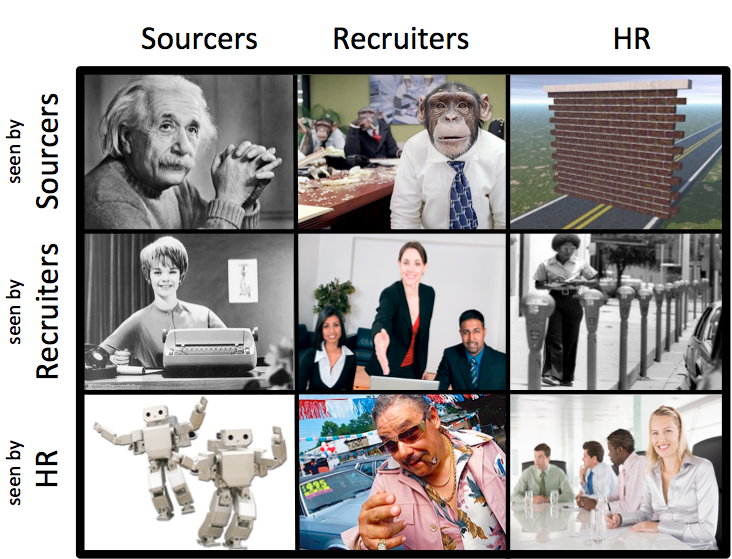Yesterday, a really funny photo was shared with me comparing developers, designers, and project managers. The image (shown here, originally created by Alex Toulemonde) demonstrates the perceptions each of these groups of individuals has not just of each other, but also of themselves. It’s hilarious — yet this is how they see one another when working together.
I started thinking… what would a similar photo montage look like if we were to show pictorially how sourcers, recruiters, and HR think of each other as well as themselves? I respectfully submit to you the following chart (following consult with actual recruiters and HR folk in addition to my own thoughts as a sourcer).

Once you’ve finished your chuckling, stop and think for a moment — and then look again at the images depicting how you, as sourcers, are viewed by your recruiting and your HR counterparts. Is this the perception you want to project to your colleagues, your peers, your partners?
I doubt it.
We, of course, think sourcing is the greatest thing. Ever. And that we, as sourcers, are the geniuses who lead our desk monkey recruiting and brick wall HR colleagues through the magical process of hiring one of our precious sourced candidates. The trouble, all too often, is that Einstein is not how we are perceived by our counterparts. Quite the contrary — recruiters are more likely to view sourcers as admins or junior recruiters. And HR professionals view sourcing as some kind of a fully automate-able function or as sort of robots.
Perception Defined
Let’s first explore perception itself. Without getting highly technical, the simple laws of perception are explained well with Gestalt psychology. Gestalt psychology states that the whole is different than the sum of its parts and describes the laws of perception as follows:
- The law of similarity: similar things tend to appear grouped together
- The law of simplicity: objects are seen in a way that makes them appear as simple as possible
- The law of proximity: things that are near each other seem to be grouped together
- The law of continuity: things are seen in a way that follows the smoothest path
- The law of closure: things are grouped together if they seem to complete some entity
How Perceptions Get (Mis)Formed
While the above principles are usually demonstrated by pictures and drawings, they help to explain why certain perceptions of people and job functions are formed. Here are some of my thoughts on why sourcing is perceived the way it is by HR and recruiters:
- They have no personal experience with a sourcer; it’s simply what they’ve observed/been told. Sometimes, recruiters and HR never have the benefit of working directly with a quality sourcer. All they know is what they’ve heard from colleagues who have. Think “law of similarity.”
- That’s what their sourcer currently does. In this case, it’s just a misclassification of job title. Because honestly, if a sourcer’s major job duties include fetching coffee or scheduling travel for candidates, they are not really a sourcer to begin with. Think “law of continuity” here.
- They’ve been told by vendors that ALL sourcing can be automated. It’s true — there are major components of sourcing that can indeed be automated. But sourcing, in my opinion, cannot be fully automated. Don’t believe me? Just read this article from Glen Cathey. Or ask anyone who’s been around sourcing for awhile — like Rob McIntosh, Jim Stroud, Shally Steckerl, Maureen Sharib (can you imagine automating phone sourcing!?), etc.
There Is a Simple Solution
What’s the best way to tackle a perception issue? Simple: education. If you don’t want your recruiter to look at you as if you’re an administrative assistant, teach him about what sourcing actually entails. Don’t refuse to do the menial tasks you may have been assigned; instead, explain to him how your time would be better spent conducting searches, doing competitive intel, and pipelining talent. Talk to your HR partners about automation — that it’s only a part of the sourcing process and that there still needs to be a skilled sourcing professional driving those automation tools or communicating with the talent surfaced through them. And most of all, exercise patience. After all, we sourcers are Einsteins — our recruiting and HR colleagues aren’t going to grasp the idea as quickly as we do!
All joking aside though, take this advice and apply it to your own perception of your recruiting and HR colleagues. They’re not all desk monkeys and brick walls (or used car salesmen or meter maids, for that matter!). Take the time to find out what their days actually consist of — it might shed some light on why there is some disconnect with your goals as a sourcer, their goals in either HR or recruiting, and the overall company goals. Remember back to the main principle of Gestalt psychology: the whole is different than the sum of its parts. By trying to understand at a higher level and encouraging your colleagues to do the same, there is less likelihood of incorrect perceptions to be formed.
